Describing all this nighttime cleanup and repair work, Dr. Daniel Barone makes one thing clear: There’s a lot we still don’t know about slumber and the disorders that impede it.
But he makes other things clear too: Better sleep is attainable for those who seek it. And, in our sleep-deprived society, more people need to do that, he says, citing dangers ranging from disease to traffic accidents to everyday fogginess.
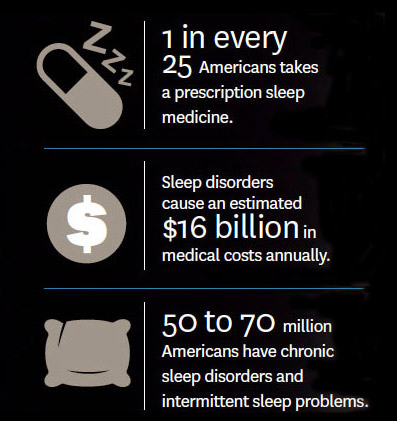
“I have a lot of patients come to me and say, ‘You know what, I’m just not as sharp as I used to be,’” he tells an audience at Webster Library on Manhattan’s Upper East Side during a presentation in July. “‘I’m not as quick as I used to be. I go into a room, I can’t remember why I’m there,’ that kind of stuff.
“There’s other reasons for that, possibly, but one of them is sleep,” says Barone, assistant professor of neurology at Weill Cornell Medicine and associate medical director of the Center for Sleep Medicine at New York-Presbyterian/Weill Cornell Medical Center.
Barone, a 2001 graduate of Fordham College at Rose Hill, serves as an increasingly public expert on sleep, appearing in media outlets and giving talks around New York. He’s finding receptive audiences and many opportunities to speak, given the growing concern about sleep deprivation, labeled a “public health epidemic” by the U.S. Centers for Disease Control and Prevention because of its links to depression, anxiety, hypertension, obesity, and cancer.
If sleep is essential, however, it’s also frustratingly hard to attain for many, one reason Barone recently authored Let’s Talk About Sleep: A Guide to Understanding and Improving Your Slumber (Rowman & Littlefield, 2018).
Written with Lawrence A. Armour, it tells the stories of patients who found their way to better slumber through considerable patience, persistence, and trial and error. Despite all the recent scientific and technological advances in the field of sleep, there are no quick fixes or standard solutions. As Barone describes it, the quest for better sleep involves not only science, medicine, and proven practices, but also a certain amount of faith.
Discovering Sleep Science
Barone grew up on Long Island, in Franklin Square, studied biology on a premed track at Fordham, and earned his medical degree from New York Medical College in Valhalla, New York. He first learned about sleep medicine when he was in residency at Saint Vincent’s Catholic Medical Center in New York City. A visiting lecturer spoke about it, and Barone was fascinated.
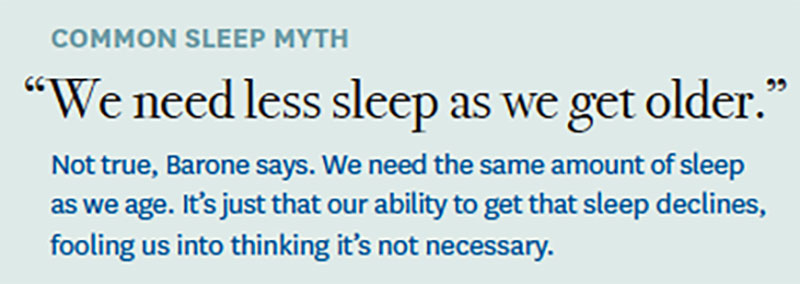 He went on to complete a one-year fellowship in sleep medicine at Stony Brook University and earned board certifications in neurology and sleep medicine from the American Board of Psychiatry and Neurology.
He went on to complete a one-year fellowship in sleep medicine at Stony Brook University and earned board certifications in neurology and sleep medicine from the American Board of Psychiatry and Neurology.
In a way, sleep medicine is still a “great frontier” because of all its unknowns, he says. Some aspects are well established: When light dims, nerve cells in the eye signal the brain’s pineal gland to release melatonin, which readies the body for sleep. While we slumber, long-term memories are solidified as the brain pares back some nerve connections and strengthens others, Barone says. And because it is a powerful antioxidant, melatonin also cleans up free radicals, metabolic byproducts that could damage cells and pave the way for heart disease or cancer.
Other functions of sleep have only recently come to light. In 2012, researchers at the University of Rochester Medical Center discovered the glymphatic system, a kind of “shadow plumbing system” in the brain, according to a university statement. It fires up only during slumber, flushing out toxins that build up during the day, including those linked to Alzheimer’s and Parkinson’s diseases. Some brain cells actually shrink to accommodate this outflow, Barone says.
But many aspects of slumber are still poorly understood, like the tipping point between our waking and sleeping states, as shown by the fact that “we never remember the exact moment at which sleep onset occurs,” Barone writes in the book.
Sleep disorders offer up plenty of unknowns as well. Barone’s research focus is REM behavior disorder, in which people act out their dreams during the rapid-eye-movement stage of sleep. Other scientists are studying restless legs syndrome, one condition that impedes the slumber of Barone’s patients. “We know so much about the brain, but there’s still a lot we don’t understand about restless legs syndrome,” he says.
A Concern for All Ages
Some sleep disruptors are better understood, like blue light from computer screens, which keeps nerve cells in the eye from triggering the release of melatonin. One of the most common disorders is sleep apnea, in which the tongue repeatedly falls back to block the airway, interrupting sleep and causing daytime drowsiness. It afflicts as many as one-quarter of middle-aged men and 9 percent of women, according to Barone, although its severity varies.
His patients have often been sleep deprived and exhausted for years. They may struggle to fall asleep, wake up too early, or wake up tired after a full night’s slumber. Some only learn about their disorders after spending a night in the Weill Cornell sleep clinic, hooked up to monitoring equipment.
Let’s Talk About Sleep includes a variety of stories from patients (identified only by first names) who volunteered to be interviewed for the book. They tend to be middle-aged or older, as sleep tends to degrade with age because of weight gain, hormonal changes, prostate issues, or other things, he says.
But young people are hardly immune to sleep troubles. As Barone describes in his book, one patient’s sleep disorder—narcolepsy—emerged in high school, causing her to fall asleep in class. And sleep needs to be a big priority for college students, no matter how overstuffed their schedules are, Barone says, noting that sleep loss is linked to anxiety and depression, and can also get in the way of one’s studies.
Barone has some experience with this. After studying all night for tests as an undergraduate at Fordham, he found that he didn’t remember much of anything unless he found time to sleep. In fact, a quick nap was enough. “I remember thinking, ‘That’s pretty amazing—just a little bit of sleep actually helps you to retain the information.’ Without it, it was almost impossible.”
Treating Sleep Loss
Treatments vary from patient to patient. Medication is just one, often short-term, option. Behavior changes, like avoiding electronic screens before bed, are also important. For insomnia, one of Barone’s preferred techniques is mindfulness meditation, which activates the relaxing parasympathetic nervous system, improving not only sleep but also one’s general mindset, he says.
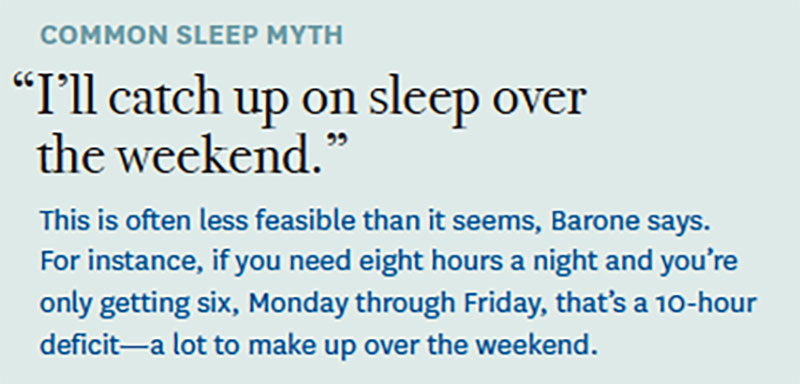 Technology also plays a role. Sleep apnea patients, for instance, may use a continuous positive airway pressure, or CPAP, mask that feeds pressurized air into their airways overnight, allowing them to sleep uninterrupted. Their other options include a dental device that pulls the jaw forward, keeping the tongue away from the back of the throat, or positioning devices to ensure they sleep on their side. One new option is a device implanted in the chest that electrically stimulates the hypoglossal nerve to keep the tongue from collapsing backward.
Technology also plays a role. Sleep apnea patients, for instance, may use a continuous positive airway pressure, or CPAP, mask that feeds pressurized air into their airways overnight, allowing them to sleep uninterrupted. Their other options include a dental device that pulls the jaw forward, keeping the tongue away from the back of the throat, or positioning devices to ensure they sleep on their side. One new option is a device implanted in the chest that electrically stimulates the hypoglossal nerve to keep the tongue from collapsing backward.
Whatever the sleep issue, the patient’s attitude is key, Barone says. Another patient mentioned in Let’s Talk About Sleep, a 61-year-old married mother of two, was waking up at midnight or 1 a.m. and tossing and turning for the rest of the night. This problem had persisted for 15 or 20 years. Then she heard an expert speak about the ill effects of sleep loss. The presentation hit home; she realized that she was in fact noticing some of the effects, like rising blood pressure, so she changed her “tough it out” attitude and sought help.
In consultation with Barone, she devised a regimen including progressive muscle relaxation, regular bedtimes, and the use of an alarm clock. Over time, her sleep improved. “It has made an incredible difference in my life,” she says in the book.
One of the most important changes she made was psychological. She developed what she called “an overall appreciation for the importance of sleep.” This appreciation doesn’t always take hold easily in the U.S., where the ability to do without sleep is viewed “almost like a badge of honor,” Barone says. “I’ve been guilty of that myself.”
Slighting the Sandman
Adults generally need seven to nine hours of sleep per night on average, according to the National Sleep Foundation. But, as stated in the book, more than a third of Americans are regularly getting inadequate shuteye. And some 50 to 70 million Americans suffer from chronic sleep disorders and periodic sleep problems, according to the National Institutes of Health.
People can be blind to the impact of sleep loss. Barone noted that one 2003 study by researchers at Harvard and the University of Pennsylvania found that people limited to six hours of sleep or less for several nights were just as impaired in a simple attention test as those who had missed as much as two whole nights of sleep.
All the same, the participants thought their bodies and minds were adjusting to the sleep loss, and that they were “doing OK” on the attention test. “In reality, they were not doing OK,” Barone says. “They were making a lot of mistakes,” and “this is just a small scale. You can imagine what’s happening when sleep deprivation is much more chronic,” he adds, naming motorists’ impaired reaction times in particular.
Such concerns are one reason why the U.S. Centers for Disease Control and Prevention has described sleep deprivation as a public health epidemic, and why Barone has accepted so many invitations to speak publicly. He hopes that it will eventually be recognized that “lack of quality sleep for a long period of time is as bad for us as smoking,” he says.
Dreaming of Better Sleep
One of sleep’s greatest mysteries is dreaming, a particular interest of Barone’s. He and other researchers are in the midst of a privately funded three-year study of REM behavior disorder, caused by a failure of the sleep paralysis that usually keeps people from acting out their dreams. Someone dreaming about being in a fight, for instance, might thrash about in bed, Barone says. While this kind of thing is alarming, the real concern—and the focus of the study—is the link between this disorder and Parkinson’s disease, he says.
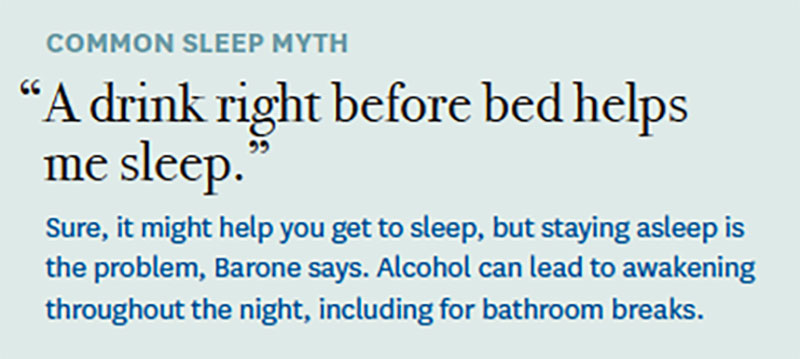 The possible benefits of dreams are the biggest question mark of all. “There must be a good reason” for them, given the amount of brainpower they require, Barone writes; the sleeping brain not only generates the content of dreams but also the slumbering mind’s experience of them, a level of activity that indicates that dreaming “is not some random thing,” he writes.
The possible benefits of dreams are the biggest question mark of all. “There must be a good reason” for them, given the amount of brainpower they require, Barone writes; the sleeping brain not only generates the content of dreams but also the slumbering mind’s experience of them, a level of activity that indicates that dreaming “is not some random thing,” he writes.
Theories abound: Dreaming may prepare us for the stresses and threats of waking life by providing a kind of dry run during sleep. They may provide a “theater of the mind” in which we work through problems, or allow us to test out emotional reactions to various situations. “There’s probably 10 different theories as to why we dream. Nobody knows for sure,” Barone says. “The brain is beyond complex,” with 100 billion neurons interacting in uncounted trillions of ways.
In Let’s Talk About Sleep, he conveys respect for sleep and the need to give it its due. Rather than serve as a medical text, the book is meant to stimulate interest in sleep, Barone writes; he urges readers to talk to a doctor about their particular sleep troubles and medical concerns. In his July presentation, he offered some tips for getting better sleep generally, like exercising and setting regular bedtimes. And he made it clear that being patient and putting one’s expectations on the shelf were also important. “None of these things are going to change your sleep overnight—pun intended,” he said.
His patients may work for weeks, months, or longer, trying different approaches and laying the groundwork for better sleep, which he describes as something to be encouraged, coaxed, cajoled. Or won over, perhaps.
“I always say, sleep is kind of like love,” Barone says. You can do all the right things and put yourself in a position to make it happen, he says, but ultimately it follows its own timetable. “I always tell patients, ‘Let me worry about your sleep. You just concentrate on doing the right things, and eventually sleep will happen.’”
]]>In a sample of nearly 6 million children born in California between 1997 and 2007, Christine Fountain, PhD and researchers from Columbia University and the Centers for Disease Control and Prevention found that the incidence of autism was twice as high for ART births compared to non-ART births.
Their findings, which were published in the American Journal of Public Health in March, are part of the largest and most diverse study to date exploring the relationship between ART and autism.
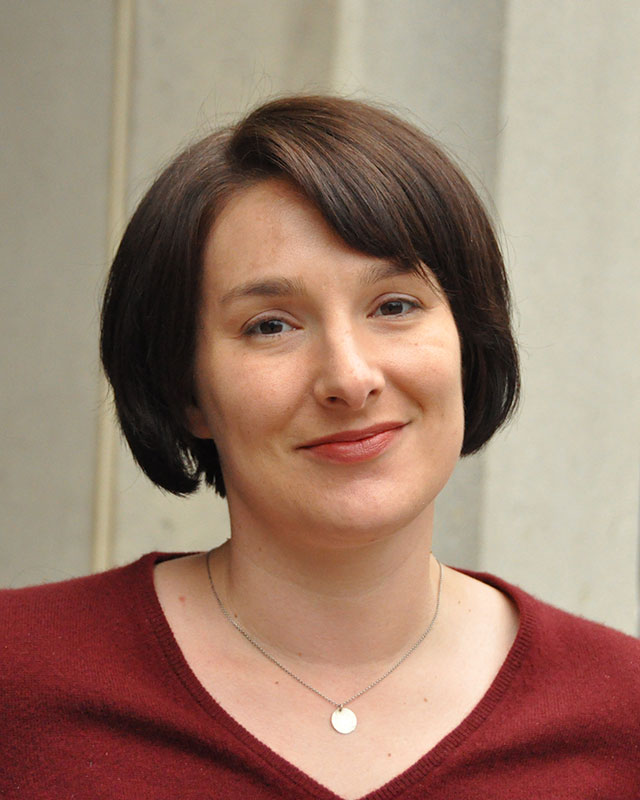
“We were interested generally in the social factors behind the increase in autism diagnoses seen over the last decade,” said Fountain, an assistant professor of sociology. “One of the broad factors we looked at was parental age. That is where ART seemed to play a role, because ART allows women to push the upper age limits for childbearing.”
Autism spectrum disorder refers to a serious development disability marked by deficits in communication and social interaction. Currently, about 1 in 68 U.S. children have been diagnosed with a form of autism—a statistic that has increased rapidly over the last decade.
The precise causes and mechanisms of autism remain unclear, but scientists have identified several risk factors, including preterm birth, low birth weight, gestational diabetes, and other complications during pregnancy. The disorder has also been linked to certain parental characteristics, such as older parental age, higher socioeconomic status and education, and white race—characteristics that are also shared by many who use ART to conceive.
The researchers also found that the incidence of autism was much higher in ART children who were part of multiple births—twins, triplets, etc.—as opposed to singleton children. A significant number of ART conceptions result in multiple births because multiple embryos are transferred during the procedure to increase the chances of a successful pregnancy.
“In general, multiple births [whether conceived by ART or not]bring greater risks of complications during pregnancy, such as gestational diabetes, preterm birth, and low birth weight, which are also risks associated with autism,” Fountain said.
Fortunately, the team’s findings suggest a potential point of intervention to help reduce the risk of autism for families who use ART.
“When appropriate, transferring one embryo rather than multiples could be a way to reduce autism risk among ART-conceived children,” Fountain said. “However, we need more research in terms of understanding the actual mechanisms by which ART and autism are linked.”
Fountain’s next research study will be an analysis of ART-born children who have naturally conceived siblings. This, Fountain hopes, could help to isolate the biological factors from social and familial factors.
“Because many ART children come from families that are relatively well-off, it’s not surprising that there would be a higher rate of diagnosis than other children,” she said. “I’m hoping to untangle some of those social factors with this new study.”
]]>Please note that this vaccination is for non-H1N1 influenza. We hope to be able to offer H1N1 vaccinations if the vaccine is approved and made available.
If you have any other questions, please don’t hesitate to contact Kathleen M. Malara, director of student health services, at (718) 817-4160; [email protected].
Students, faculty and staff from any campus are welcome at any location and date.
Tuesday, September 22, 2009 | 10 a.m. to 2 p.m.
McGinley Commons, Room 236 | Rose Hill Campus
Wednesday, September 23, 2009 | 4 to 8 p.m.
McGinley Commons, Room 236 | Rose Hill Campus
Tuesday, October 6, 2009 | 10 a.m. to 2 p.m.
McMahon Hall, Room 205-206 | Lincoln Center Campus
Wednesday, October 7, 2009 | 4 to 8 p.m.
McMahon Hall, Room 205-206 | Lincoln Center Campus
Cost: $30, payable in cash or check only.
Participants will be required to have proper identification and sign a consent form before receiving a flu shot.
Below are answers to frequently asked flu questions. You may also visit the Federal Centers for Disease Control and Prevention (CDC) website at: http://www.cdc.gov/flu.
Q: Will I get the flu from the flu shot?
A: No. The flu vaccine is created from dead or inactive viruses that are not contagious.
Q: Do I need a flu shot every year?
A: Yes. Influenza viruses continually change every year. A new vaccine is used annually to fight the most current influenza virus. In addition, the antibody a person develops from the vaccine declines over time.
Q: When should I get a flu shot?
A: Influenza usually occurs as early as October and can last as late as May, with activity peaking between late December and early March. The optimal time for flu shots is during October through November; however it is clinically beneficial to be vaccinated through December and January.
Q: Why get a flu shot?
A: Influenza usually leaves its victims unable to function for several days and is responsible for an average of 200,000 hospitalizations due to flu complications each year.* Getting an annual flu shot is your best protection.
*Center for Disease Control and Prevention, July 2005.
Q: How effective is the flu shot?
A: The flu vaccine has been determined to be effective in preventing influenza in about 70 percent to 90 percent of healthy people under the age of 65 and is your best method of protection. Among elderly persons not living in chronic-care facilities and people with long-term medical conditions, the flu shot is 30 percent to 70 percent effective in preventing hospitalization for pneumonia and influenza. Among elderly nursing home residents, the flu shot is most effective in preventing severe illness, secondary complications, and deaths related to the flu. In this population, the shot can be 50%-60% effective in preventing hospitalization or pneumonia and 80% effective in preventing death from the flu.
Q: Who should get a flu shot?
A: The CDC recommends that you receive a flu shot if you meet one or more of the following criteria:
o Anyone who wants to reduce the risk of contracting the flu
o People at high risk of having serious complications from influenza, including:
• Children aged 6 months – 18 years old
• Pregnant women
• People 50 years of age and older
• People of any age with certain chronic medical conditions
• People who live in nursing homes and other long term care facilities
• People who live with or care for those at high risk for complications from flu
Q: Can I still get the flu after I get the flu shot?
A: Yes. Like other vaccines, flu vaccine is not 100 percent effective and does not take effect until one or two weeks after it is received. During this time, you will be just as susceptible to contract the flu as individuals who have not received the vaccination. Still, the best option to prevent flu is to get a yearly flu shot.
Q: What are the side effects of getting a flu shot?
A: For most people, vaccination causes no side effects. Less than 1/3 of those who receive a flu shot will experience some soreness at the vaccination site, and only 5 to 10 percent will suffer mild side effects such as low-grade fevers and headaches. Anyone who is allergic to eggs should avoid being vaccinated, since the virus used is grown in hens’ eggs.
“Psychologists have a lot to contribute to shaping HIV/AIDS policy and informing HIV/AIDS research given our expertise in understanding decision making and behavior,” Wallace said. “This is important for informing prevention and treatment efforts.”
In her new position, Scyatta will be one of six COPA members to help shape the APA’s policy regarding the HIV epidemic. All members are chosen for their expertise and commitment to AIDS-related issues.
The APA is a scientific and professional organization that represents psychology in the United States, and, with 148,000 members, the largest association of psychologists worldwide. It supports legislation on mental health issues, encourages new research initiatives and assists community-based organizations with volunteer members.
Scyatta said she first became interested in the problem of HIV among youth when she was a doctoral student at Fordham. For her practicum in applied developmental psychology, she was assigned an evaluation of HIV testing and treatment among homeless youth at a Manhattan outreach center.
Today, Scyatta’s research is funded by the National Institutes of Health and the Centers for Disease Control and Prevention. She focuses on HIV prevention among African-American youth, and looks at factors that affect their risk-taking and substance abuse behaviors.
Scyatta taught at the SUNY Downstate Medical Center in Brooklyn before moving to St. John’s in 2008.
]]>